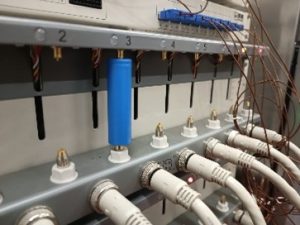Our laboratories are equipped for working with commercial cells and battery modules, as well as for research and development at the materials level.
Equipment for Battery Testing and Diagnostics
The laboratory is equipped with modern devices for testing and characterizing battery cells and modules, allowing a wide range of experiments to be conducted under controlled conditions. Verifying parameters stated in technical data sheets and their comprehensive characterization in various operating modes is a daily part of applied battery research. Testing serves not only to verify specifications with the real behavior of cells but also as input data for model development. The tests allow for identification and tracking of degradation processes and studying the lifespan of batteries depending on various factors. For this, battery testers are used that enable precise control of charging and discharging profiles, along with climatic chambers that ensure a controlled temperature environment.
Battery Testers
Cell Testing:
- 16 channels (5 V/50 mA) – for testing very small and experimental cells, such as coin cells.
- 48 channels (5 V/12 A) – for testing small cells, often used in consumer electronics, aerospace, and various other applications. This typically includes cylindrical 18650 and 21700 cells.
- 8 channels (5 V/100 A) – for testing large cells, typically intended for stationary storage or automotive applications.
Module Testing:
- 4 channels (60 V/20 A) – for testing smaller modules.
- 4 channels (60 V/200 A) – for testing large modules.
Specialized Measuring Instruments:
- EIS Measuring Instrument – Inspectrum.C 105 RT-EIS – an instrument for measuring electrochemical impedance spectroscopy.
Climatic Chambers
A stable and controlled ambient temperature is fundamental for high-quality and repeatable tests. For this, we use chambers in various sizes. We have at our disposal:
- 2x 55 l Memmert, 0–70 °C.
- 1x 260 l Memmert, 0–70 °C.
- 1x 260 l Memmert, -12–60 °C.
- 1x 750 l Memmert, 0–70 °C.
- 1x 600 l Weiss, -70–180 °C.
- 8x CellPod, -20–70 °C.
Equipment for Battery Materials Characterization
Advanced material analysis is a cornerstone for research and innovation in the field of battery technologies. It allows us to examine in detail the morphology, structure, and chemical composition of key components, such as electrodes, separators, or active materials. The data obtained is crucial not only for the development of new, more efficient, and safer batteries but also for the optimization of recycling processes and the recovery of valuable raw materials from used cells or directly from black mass.
Microscopy
- Scanning Electron Microscope (SEM) Thermo Scientific Phenom ProX, which serves to observe the surface of materials at high resolution and for the analysis of their elemental composition.
- Confocal Microscope Keyence VK-X1000, which is used for contactless 3D measurement and detailed analysis of the shape and roughness of the surface of the materials being examined.
- Zoom Stereomicroscope Olympus SZX7, which serves to observe samples in 3D at lower magnification, which is ideal for initial visual inspection and preparation of samples before a more detailed analysis.
Thermal Analyses
- TA Instruments TMA Q400, or an instrument for thermomechanical analysis, which measures dimensional changes of materials (expansion or shrinkage) depending on temperature. This analysis is key for evaluating the stability of separators and electrodes under thermal load.
- Setsys Evolution TG-DTA/DSC represents a system for comprehensive thermal analysis. It combines TG – Thermogravimetry (monitoring mass changes of a material upon heating) and DTA/DSC – Differential Thermal Analysis / Differential Scanning Calorimetry (measuring heat flows associated with phase transitions or chemical reactions). This method is fundamental for studying the thermal stability and degradation of materials.
Chemical Analyses and Spectrometry
- Gas Chromatograph with Mass Spectrometer (GC-MS) Thermo Fisher Scientific Trace 1310 GC ISQ 7000, which enables the separation and identification of volatile and semi-volatile organic substances. In battery research, it is used, for example, for the analysis of the composition and degradation of electrolytes, the detection of gases released during the aging or failure of cells, or the analysis of wastewater from electrochemical discharging of cells..
- Digital Multimeter WTW Multi 3630 IDS SET G is an instrument for the electrochemical analysis of solutions. It allows for the measurement of key parameters, such as pH, conductivity, and dissolved oxygen concentration. It is essential for characterizing the properties of liquid electrolytes or for controlling the processes of electrochemical battery discharging or hydrometallurgical battery recycling.



